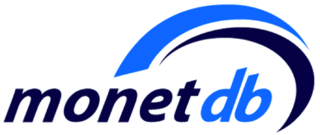
In computing, a database is an organized collection of data or a type of data store based on the use of a database management system (DBMS), the software that interacts with end users, applications, and the database itself to capture and analyze the data. The DBMS additionally encompasses the core facilities provided to administer the database. The sum total of the database, the DBMS and the associated applications can be referred to as a database system. Often the term "database" is also used loosely to refer to any of the DBMS, the database system or an application associated with the database.

MySQL is an open-source relational database management system (RDBMS). Its name is a combination of "My", the name of co-founder Michael Widenius's daughter My, and "SQL", the acronym for Structured Query Language. A relational database organizes data into one or more data tables in which data may be related to each other; these relations help structure the data. SQL is a language that programmers use to create, modify and extract data from the relational database, as well as control user access to the database. In addition to relational databases and SQL, an RDBMS like MySQL works with an operating system to implement a relational database in a computer's storage system, manages users, allows for network access and facilitates testing database integrity and creation of backups.

MonetDB is an open-source column-oriented relational database management system (RDBMS) originally developed at the Centrum Wiskunde & Informatica (CWI) in the Netherlands. It is designed to provide high performance on complex queries against large databases, such as combining tables with hundreds of columns and millions of rows. MonetDB has been applied in high-performance applications for online analytical processing, data mining, geographic information system (GIS), Resource Description Framework (RDF), text retrieval and sequence alignment processing.
A document-oriented database, or document store, is a computer program and data storage system designed for storing, retrieving and managing document-oriented information, also known as semi-structured data.
An embedded database system is a database management system (DBMS) which is tightly integrated with an application software; it is embedded in the application. It is a broad technology category that includes:
Polyhedra is a family of relational database management systems offered by ENEA AB, a Swedish company. The original version of Polyhedra was an in-memory database management system which could be used in high availability configurations; in 2006 Polyhedra Flash DBMS was introduced to allow databases to be stored in flash memory. All versions employ the client–server model to ensure the data are protected from misbehaving application software, and they use the same SQL, ODBC and type-4 JDBC interfaces. Polyhedra is targeted primarily for embedded use by Original Equipment Manufacturers (OEMs), and big-name customers include Ericsson, ABB, Emerson, Lockheed Martin, United Utilities and Siemens AG.
Altibase is a hybrid database, relational database management system manufactured by the Altibase Corporation. The software's hybrid architecture allows it to access both memory-resident and disk-resident tables using single interface. It supports both synchronous and asynchronous replication and offers real-time ACID compliance. Support is also offered for a variety of SQL standards and programming languages. Other important capabilities include data import and export, data encryption for security, multiple data access command sets, materialized view and temporary tables, and others.
NoSQL is an approach to database design that focuses on providing a mechanism for storage and retrieval of data that is modeled in means other than the tabular relations used in relational databases. Instead of the typical tabular structure of a relational database, NoSQL databases house data within one data structure. Since this non-relational database design does not require a schema, it offers rapid scalability to manage large and typically unstructured data sets. NoSQL systems are also sometimes called "Not only SQL" to emphasize that they may support SQL-like query languages or sit alongside SQL databases in polyglot-persistent architectures.
H-Store is an experimental database management system (DBMS). It was designed for online transaction processing applications. H-Store was developed by a team at Brown University, Carnegie Mellon University, the Massachusetts Institute of Technology, and Yale University in 2007 by researchers Michael Stonebraker, Sam Madden, Andy Pavlo and Daniel Abadi.
Clustrix, Inc. is a San Francisco-based private company founded in 2006 that developed a database management system marketed as NewSQL.
eXtremeDB is a high-performance, low-latency, ACID-compliant embedded database management system using an in-memory database system (IMDS) architecture and designed to be linked into C/C++ based programs. It works on Windows, Linux, and other real-time and embedded operating systems.

SingleStore is a proprietary, cloud-native database designed for data-intensive applications. A distributed, relational, SQL database management system (RDBMS) that features ANSI SQL support, it is known for speed in data ingest, transaction processing, and query processing.
NewSQL is a class of relational database management systems that seek to provide the scalability of NoSQL systems for online transaction processing (OLTP) workloads while maintaining the ACID guarantees of a traditional database system.
Aerospike Database is a real-time, high performance NoSQL database. Designed for applications that cannot experience any downtime and require high read & write throughput. Aerospike is optimized to run on NVMe SSDs capable of efficiently storing large datasets. Aerospike can also be deployed as a fully in-memory cache database. Aerospike offers Key-Value, JSON Document, Graph data, and Vector Search models. Aerospike is open source distributed NoSQL database management system, marketed by the company also named Aerospike.

A key–value database, or key–value store, is a data storage paradigm designed for storing, retrieving, and managing associative arrays, and a data structure more commonly known today as a dictionary or hash table. Dictionaries contain a collection of objects, or records, which in turn have many different fields within them, each containing data. These records are stored and retrieved using a key that uniquely identifies the record, and is used to find the data within the database.
The Yahoo! Cloud Serving Benchmark (YCSB) is an open-source specification and program suite for evaluating retrieval and maintenance capabilities of computer programs. It is often used to compare the relative performance of NoSQL database management systems.
The following outline is provided as an overview of and topical guide to MySQL:

RocksDB is a high performance embedded database for key-value data. It is a fork of Google's LevelDB optimized to exploit multi-core processors (CPUs), and make efficient use of fast storage, such as solid-state drives (SSD), for input/output (I/O) bound workloads. It is based on a log-structured merge-tree data structure. It is written in C++ and provides official language bindings for C++, C, and Java. Many third-party language bindings exist. RocksDB is free and open-source software, released originally under a BSD 3-clause license. However, in July 2017 the project was migrated to a dual license of both Apache 2.0 and GPLv2 license. This change helped its adoption in Apache Software Foundation's projects after blacklist of the previous BSD+Patents license clause.
Google Cloud Datastore is a highly scalable, fully managed NoSQL database service offered by Google on the Google Cloud Platform. Cloud Datastore is built upon Google's Bigtable and Megastore technology. Google Cloud Datastore allows the user to create databases either in Native or Datastore Mode. Native Mode is designed for mobile and web apps, while Datastore Mode is designed for new server projects.

In database theory, the PACELC theorem is an extension to the CAP theorem. It states that in case of network partitioning (P) in a distributed computer system, one has to choose between availability (A) and consistency (C), but else (E), even when the system is running normally in the absence of partitions, one has to choose between latency (L) and loss of consistency (C).







